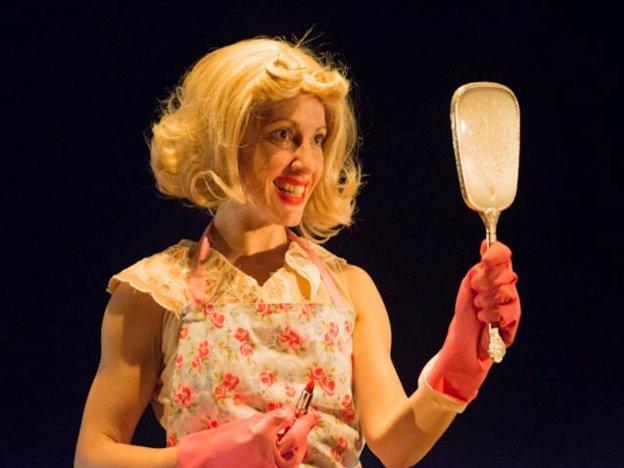A bright, full moon shone as I walked to Liverpool’s Unity Theatre to see Wolf Red, the first solo show from Elinor Randle, one half of innovative Liverpool-based company Tmesis Theatre. Even in the city it is impossible not to entertain sublunary thoughts of wildness and lurking threat. By even wilder contrast, Wolf Red is ostensibly about a young woman held captive in a room in the depths of the forest. More intriguingly, the show explores the ambiguity around the idea of ‘captivity’ and captive space to address themes of madness and female domesticity. Such shifts are mobilised by the postmodern mix of the show’s narrative sources, which jump-cut between, for instance, Little Red Riding Hood, Beauty and the Beast, and The Red Shoes to build a coherent feminist critique of fairy stories.
Elinor Randle’s first appearance, in yards of lush, blood-red material tightly wrapped around her head and cascading to the floor, breaks the silence with an incantatory text direct from the darkest corner of the fairytale world. As Randle exhorts a young girl to be wary on her way in life, her delivery is razor-sharp and ever so chilling – a fact heightened as she rises slowly on a tree trunk to the very lupine source of light I thought I’d turned my back on as I entered the theatre.
But who was this figure? Was she the postmodern realisation of Red Riding Hood aged into hardened cynicism? The following image of Randle writhing on a mattress under the same red cloth, as if being born into the story, seemed to suggest that narrative is a mode of transmission through which characters undergo continual metamorphosis.
Lois Maskell’s sparse set design was all the more intensely evocative of the wayward paths luring any young fairytale girl to her destiny: a sculptural branch hanging adrift as a minimalist symbol of the primeval; alone on the fringe, the fat trunk of the tree. And so combative was Randle’s physicality (in one scene echoing a bull-fight) that the square space marked out as ‘the room’ may just as well have been a boxing ring, albeit one for the conflict between the phantasms of the mind and the phantoms of the forest. Messy earth and brittle fragments of tree appear to have been kicked around the edges of the space as if to suggest there is no escape from the depths of the forest – or equally, from the girl’s attenuated mental landscape.
Wolf Red shifts between the otherworldly time of the fairytale and the concrete time of history: recalling gender servitude and oppression in 1950s America, Randle danced to Doris Day’s ‘Tea for Two’ having transformed her primitive near-nakedness into a feminine cliché of blonde wig, floral-patterned dress, gaudy red lipstick, and shoes just like Dorothy’s. Such shifts and transformations seem to be motivated by a critique of storytelling as patriarchal ideology, and in this way Wolf Red betrays more than a hint of Angela Carter’s remodelling of fairytales in The Bloody Chamber. As in Carter’s stories, the key to female liberation is in the subversion of tradition. This accounts for the nuanced irony in Randle’s performance. The title of Day’s song was undercut by the fact that this young female danced alone, with only the company of her pillow, a prop swung around by the skin of the performer’s teeth and repeatedly dashed to the floor, flying feathers as collateral damage.
Poignancy slipped in during such moments, but not for long: the red lipstick became wilder and more clown-like in its application the more she cleaned the room, signalling a psychological turn for the worse while heralding emancipation from the conventions of feminine beauty. The feather duster used to comic effect for the cleaning left little doubt in this regard as she inserted it in her apron pocket and rubbed herself to a relieved climax to Day’s ‘Never Underestimate a Woman’s Touch’. While in the song the woman’s touch is domestic and placed in the service of others, this one was very much her own. Some may view this scene as precipitating her ultimate breakdown, her invitation to the wolf – ‘Come in, come in, come in’. But in a way there was no such beast as the wolf. Instead, and far more disturbingly, the wolf was the beast within: it was the girl’s latent sexuality, repressed and contained by the captive space of a mind numbed by patriarchy.
Although Wolf Red is Randle’s first solo show, the programme notes emphasise the collaborative nature of the project. Directed by Yorgos Karamalegos (the other half of Tmesis Theatre), it was devised in collaboration with Chris Fittock, who also wrote the finely tuned text. There was creative input from international practitioners too, the late and sadly missed Nigel Charnock having provided the initial creative input. Wolf Red consolidates Tmesis Theatre’s growing reputation as an exciting company dedicated to expanding their medium, a status underpinned by their creation of Physical Fest, Liverpool’s annual and hugely popular celebration of physical theatre and contemporary dance. But without doubt Elinor Randle’s virtuosity is impressive on its own terms, bearing the hallmarks of crisp articulation and fluency of movement, deft characterisations, wit and verve. It is a performance that balances being serious with not taking itself seriously. Wolf Red is a dark and exhilarating journey of moods and ideas that harnesses physical theatre’s rich symbiosis of movement and acting to startling effect.


